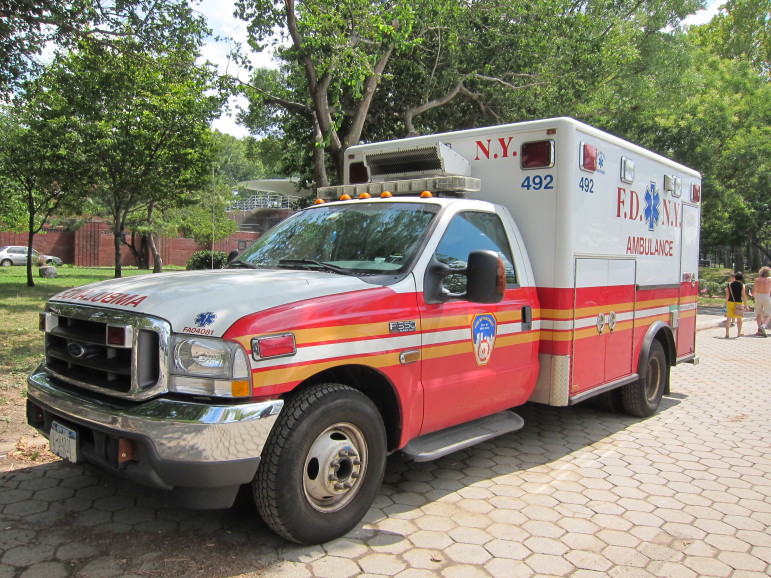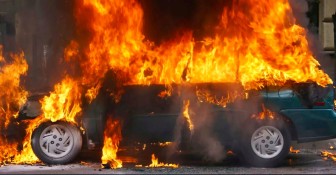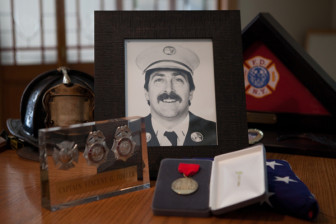
Phil Wiffen
The 1996 merger of New York City's emergency medical and fire services changed dramatically the workload of many fire companies.
Last year the New York City Fire Department responded to nearly 62,000 fire incidents, or roughly 160 every day. That’s a lot. But it actually reflects a step drop in firefighting over the previous 16 years—a 49 percent drop in fire incidents since 1998. Over the same period, the number of medical emergencies that FDNY handled jumped by a third. New York’s firefighters now respond to medical calls 15 times more often than they rush to potential fire scenes.
The change in FDNY workload (which City Limits reported on in July) has many causes, but one is the 1996 merger of the city’s emergency medical service with its fire service. A report out Wednesday from the Citizens Budget Commission argues the city needs to retool FDNY to reflect the change in its work.
“When a New Yorker sees a firetruck heading down the street with its lights flashing and siren
sounding, the odds are less than one in five that the firefighters are headed to a fire; it is
more likely that they are responding to a medical emergency,” the report reads. The problem, CBC says, is that “the FDNY does not efficiently address its most common job: responding to medical emergencies.”
For instance:
Response times for engine companies are generally quicker than for ambulances, but firefighter response is limited in important ways. First, firefighters cannot offer transport to a hospital; engines are not equipped to transfer patients, and firefighters cannot be ‘out of commission’ for very long in the event there is a fire or other emergency. Second, firefighters have less extensive medical training than EMTs and paramedics; even when firefighters can provide meaningful assistance, protocols require an ambulance to arrive and take over, necessitating a redundant dual response.
While the department has identified that problem and promised some reforms, CBC says it’s not being bold enough in dealing with the mismatch.
What does CBC propose? Right now, the city uses two paramedics on “advanced life support” ambulances, which deal with more serious situations than “basic life support” ambulances. CBC wants the city to staff ambulances more efficiently, with one paramedic and one emergency medical technician; EMTs receive substantially less training and are paid lower salaries. The commission also suggests FDNY provide more medical training to firefighters, so they can effectively handle a broader range of medical emergencies without needing an ambulance.
CBC is less specific about what it wants over the long term, but it clearly implies that the city needs more EMTs and paramedics and fewer firefighters. “The relationships between the two services should be redefined, and the financial and human resources provided for each type of service should be rebalanced,” the report reads. “This will require rethinking not only personnel training, but the types of equipment needed and the use, placement, and deployment of these assets.”
Such a change will encounter a lot of resistance, and not just because of the cultural shift it would impose on the nation’s preeminent fire service. The nature of fire and of firefighting necessitate a quick and overwhelming response when something is burning, and given urban geography, there might be limits to how much New York’s firefighting capabilities can be scaled back, even as the number of blazes continues to decline.
 NYC’s Battle Against Arson
NYC’s Battle Against Arson
May 2014
A key factor in the city’s history, but largely left out of today’s discussions of crime, arson has seen a dramatic decline in New York. But changes in investigative techniques and cuts to the city’s arson investigation unit raise questions about whether intentional fire-setting is as rare as the statistics suggest.
 Why Firefighters Die
Why Firefighters Die
September 2011
Time did not stop on September 11, 2001. The city soon went back to living and working and burning. The FDNY battled a quarter of a million structural fires in the decade after the twin towers fell. And it lost 11 men doing so. In the decade before 9/11, 21 firefighters perished on the job. Is New York doing enough to protect the bravest?








One thought on “Budget Hawks Want FDNY to Retool for an Era of Fewer Fires”
Why not just hire more emt’so and paramedics? The members of this commission are idiots.